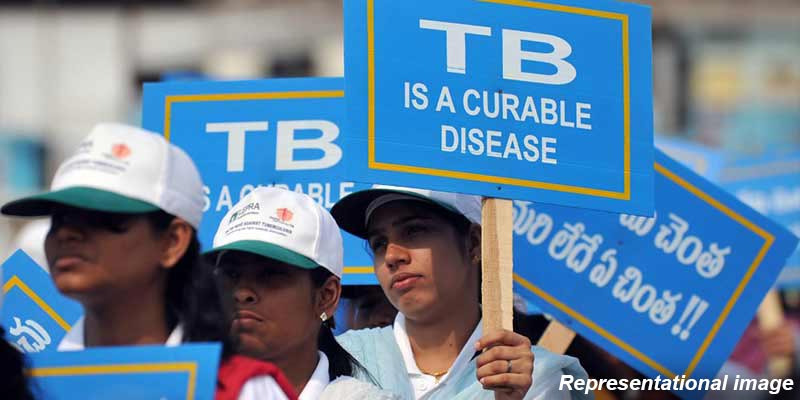- World
- Oct 30
Tuberculosis replaces COVID-19 as top infectious disease killer
• The World Health Organisation (WHO) published the Global Tuberculosis Report 2024.
• It revealed that approximately 8.2 million people were newly diagnosed with TB in 2023 — the highest number recorded since WHO began global TB monitoring in 1995.
• This represents a notable increase from 7.5 million reported in 2022, placing TB again as the leading infectious disease killer in 2023, surpassing COVID-19.
Key points of the report:
• The report highlights mixed progress in the global fight against TB, with persistent challenges such as significant underfunding.
• While the number of TB-related deaths decreased from 1.32 million in 2022 to 1.25 million in 2023, the total number of people falling ill with TB rose slightly to an estimated 10.8 million in 2023.
• With the disease disproportionately affecting people in 30 high-burden countries, India (26 per cent), Indonesia (10 per cent), China (6.8 per cent), the Philippines (6.8 per cent) and Pakistan (6.3 per cent) together accounted for 56 per cent of the global TB burden.
• About 55 per cent of people who developed TB were men, 33 per cent were women and 12 per cent were children and young adolescents.
• In 2023, the gap between the estimated number of new TB cases and those reported narrowed to about 2.7 million, down from COVID-19 pandemic levels of around 4 million in 2020 and 2021. This follows substantial national and global efforts to recover from COVID-related disruptions to TB services.
• The coverage of TB preventive treatment has been sustained for people living with HIV and continues to improve for household contacts of people diagnosed with TB.
• However, multidrug-resistant TB remains a public health crisis. Treatment success rates for multidrug-resistant or rifampicin-resistant TB (MDR/RR-TB) have now reached 68 per cent. But, of the 400,000 people estimated to have developed MDR/RR-TB, only 44 per cent were diagnosed and treated in 2023.
• Global funding for TB prevention and care decreased further in 2023 and remains far below target. Low and middle-income countries, which bear 98 per cent of the TB burden, faced significant funding shortages. Only $5.7 billion of the $22 billion annual funding target was available in 2023, equivalent to only 26 per cent of the global target.
• The United States government remains the largest bilateral donor for TB.
• A significant number of new TB cases are driven by five major risk factors: undernutrition, HIV infection, alcohol use disorders, smoking (especially among men), and diabetes.
• Tackling these issues, along with critical determinants like poverty and GDP per capita, requires coordinated multisectoral action.
• Global milestones and targets for reducing the TB disease burden are off-track, and considerable progress is needed to reach other targets set for 2027 ahead of the second UN High-Level Meeting.
Tuberculosis
• Tuberculosis is caused by bacteria (Mycobacterium tuberculosis) that most often affect the lungs. It can spread when people who are sick with TB expel bacteria into the air – for example, by coughing.
• Every year, 10 million people fall ill with TB. Despite being a preventable and curable disease, 1.5 million people die from TB each year.
• TB is the leading cause of death of people with HIV and also a major contributor to antimicrobial resistance.
• Most people who develop the disease are adults.
• TB is preventable and curable. About 85 per cent of people who develop TB disease can be successfully treated with a 4/6-month drug regimen. Treatment has the added benefit of curtailing onward transmission of infection.
• Economic and financial barriers can affect access to health care for TB diagnosis and completion of TB treatment; about half of TB patients and their households face catastrophic total costs due to TB disease.
• Progress towards universal health coverage (UHC), better levels of social protection and multisectoral action on broader TB determinants are all essential to reduce the burden of TB disease.
Indian govt’s initiatives to combat TB
• The government implements the National TB Elimination Programme (NTEP) under the aegis of the National Health Mission (NHM).
• The National Strategic Plan for TB Elimination (2017-25) was approved on May 8, 2017 and is being implemented in the entire country. It is a multi-pronged approach that aims to detect all TB patients with an emphasis on reaching TB patients seeking care from private providers and undiagnosed TB in high-risk populations.
• The National Tuberculosis Elimination Programme (NTEP), previously known as Revised National Tuberculosis Control Programme (RNTCP), aims to strategically reduce TB burden in India by 2025, five years ahead of the Sustainable Development Goals.
• In September 2022, President Droupadi Murmu launched Pradhan Mantri TB Mukt Bharat Abhiyan, to provide additional nutritional support to those on TB treatment, through contributions from community and organisations.
• Pradhan Mantri TB Mukt Bharat Abhiyan (PMTBMBA) was launched on September 9, 2022 for community support to TB patients with the objective to provide people with TB with additional nutritional, diagnostic and vocational support. Under the scheme, more than one lakh Ni-kshay Mitras (donors) are supporting over 11 lakh TB patients all over the country presently.
• In March 2023, Prime Minister Narendram Modi launched various initiatives, including the TB-Mukt Panchayat initiative to leverage the support of over 2.5 lakh Gram Panchayats to raise awareness about TB.
Manorama Yearbook app is now available on Google Play Store and iOS App Store



